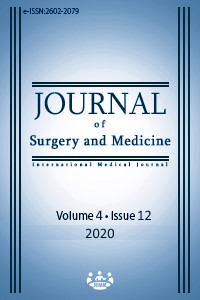Determinants of amputation and mortality following thromboembolectomy in native acute lower limb arterial occlusions, the influence of early intervention: A retrospective cohort study
Keywords:
Amputation, Balloon embolectomy, Acute arterial occlusionAbstract
Aim: In acute arterial occlusion, there is a sudden blockage of blood flow to the extremity, threatening its viability. Early/emergency intervention is required to eliminate the risk of amputation, but some of these cases receive a delayed diagnosis. The aim of this study is to evaluate the influence of surgical timing on the incidence of amputation and other factors affecting the risk of extremity loss. Methods: A total of 154 patients who underwent thromboembolectomy were analyzed. The patients were categorized into three groups, as follows: Group 1 included patients with symptoms present for less than 12 hours, Group 2 comprised those with symptoms present for more than 12 hours but less than one week, and Group 3 included patients with symptoms present for more than one week. The groups were evaluated in terms of amputation and mortality. Results: The incidence of amputation was significantly lower in Group 1 compared to the other two groups (P<0.05), and similar between Groups 2 and 3. In-hospital mortality did not significantly differ between the groups. When categorical and continuous variables were evaluated, a significant relationship was found between the risk of amputation and increasing age, female gender, diabetes, and iliac occlusion (P<0.05). The risk of in-hospital mortality was higher in females and in cases with cardiac arrhythmia (P<0.05). Conclusion: Early surgical embolectomy is more successful in limb salvage. The risk of amputation is increased in diabetics, females, the elderly, and in proximal arterial occlusion.
Downloads
References
Obara H, Matsubara K, Kitagawa Y. Acute Limb Ischemia. Ann Vasc Dis. 2018;11:443–8.
Hage AN, McDevitt JL, Chick JFB, Vadlamudi V. Acute Limb Ischemia Therapies: When and How to Treat Endovascularly. Semin Intervent Radiol. 2018;35:453–60.
PRATT GH. Arterial varices; a syndrome. Am J Surg. 1949;77:456-60.
Olinic DM, Stanek A, Tătaru DA, Homorodean C, Olinic M. Acute Limb Ischemia: An Update on Diagnosis and Management. J Clin Med. 2019;8:1215.
Moon HG, Cho SC, Jeong SW, Lee GI, Jo YE, Youn B, et al. Early versus late thrombolysis in acute arterial occlusion of lower extremity. Int J Cardiol. 2017;228:86-9.
Acar RD, Sahin M, Kirma C. One of the most urgent vascular circumstances: Acute limb ischemia. SAGE Open Med. 2013;1:2050312113516110.
McNally MM, Univers J. Acute Limb Ischemia. Surg Clin North Am. 2018 ;98:1081-96.
Lind B, Morcos O, Ferral H, Chen A, Aquisto T, Lee S, Lee CJ. Endovascular Strategies in the Management of Acute Limb Ischemia. Vasc Specialist Int. 2019 Mar;35:4-9.
Farber A, Eberhardt RT. The Current State of Critical Limb Ischemia: A Systematic Review. JAMA Surg. 2016;151:1070-7.
Gülmen Ş . Akut arter tıkanıklarınnda mortaliteye eşlik eden faktörler. SDÜ Tıp Fakültesi Dergisi. 2009;15:12-6.
Carmona GA, Hoffmeyer P, Herrmann FR, Vaucher J, Tschopp O, Lacraz A, et al. Major lower limb amputations in the elderly observed over ten years: the role of diabetes and peripheral arterial disease. Diabetes Metab. 2005;31:449-54.
Narres M, Kvitkina T, Claessen H, Droste S, Schuster B, Morbach S, Rümenapf G, Van Acker K, Icks A. Incidence of lower extremity amputations in the diabetic compared with the non-diabetic population: A systematic review. PLoS One. 2017;12:e0182081.
Clason AE, Stonebridge PA, Duncan AJ, Nolan B, Jenkins AM, Ruckley CV. Morbidity and mortality in acute lower limb ischaemia: a 5-year review. Eur J Vasc Surg. 1989;3:339-43.
Liang S, Zhou L, Ye K, Lu X. Limb Salvage after Percutaneous Mechanical Thrombectomy in Patients with Acute Lower Limb Ischemia: A Retrospective Analysis from Two Institutions Ann Vasc Surg. 2019;58:151-9.
Demi̇r D , Kahraman N . Outcomes of intravenous thrombolytic and adjuvant surgery in acute limb ischemia: Review of 23 patients. J Surg Med. 2019;3(2):172-5.
Strom JA, Bernhard VM, Towne JB. Acute Limb Ischemia Following Aortic Reconstruction: A Preventable Cause of Increased Mortality. Arch Surg. 1984;119:470–3.
Hussain MA, Lindsay TF, Mamdani M, Wang X, Verma S, Al-Omran M. Sex Differences in the outcomes of peripheral arterial disease: a population-based cohort study. CMAJ Open. 2016;4:E124‐31.
Downloads
- 452 646
Published
Issue
Section
How to Cite
License
Copyright (c) 2020 Selim Durmaz
This work is licensed under a Creative Commons Attribution-NonCommercial-NoDerivatives 4.0 International License.
















